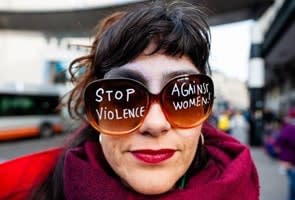Violence against women is a universal problem, yet its media reportage and the academic research in the #MeToo era is centred on the Global North.
Andrea Baker
Senior Lecturer, School of Media, Film and Journalism
Two in three women in the Global South experience physical or sexual violence, mostly from an intimate partner, which is a higher ratio than the Global North.
Our 2022 edited collection, Reporting on Sexual Violence in the #MeToo Era, found that the media coverage in the Global North has shifted beyond a sensationalist trope of violence against women as an spontaneous “out of the blue” event, perpetrated by men, asserting it as a widespread societal issue.
However, drawing on cases in Australia, the US, United Kingdom, Denmark, Sweden, Norway, Israel, Japan, and India, in the collection 15 journalism scholars found that media coverage in the #MeToo era focused on sexual harassment, backed up by a microcosm of white, middle to upper-class, cis-gendered feminist discourses.
Acknowledging inequities are a leading risk factor for violence against women, Reporting on Sexual Violence in the #MeToo Era called for more media research linking intersections of violence to class, gender, race, sexuality, disability, and those with mental health issues.

The Global South includes countries whose economies are usually not fully developed and often face challenges such as unstable democracies, huge population growth, low per-capita income, and excessive unemployment. It includes Southeast and Central Asia, parts of the Pacific region and the Middle East, Africa, Latin America, and the Caribbean.
Our 2023 edited collection, Violence Against Women in the Global South: Reporting in the #MeToo Era, highlights that the majority of the global population reside in this region where inequities are more acutely felt, yet violence against women receives minimal media coverage or scholarly investigation.
That collection brought together 14 journalism scholars from 11 of the 67 countries, such as Southeast Asia (Indonesia), sub-Saharan Africa (Kenya, Nigeria and South Africa), and the Middle East and North Africa (Egypt, Libya, Syria, and Yemen). It also included Latin American countries such as Argentina, Brazil, and Mexico, which have solid economic growth, but are part of the Global South because of inequity issues.

Violence Against Women in the Global South: Reporting in the #MeToo Era highlights structural and systemic challenges for journalists who report on violence against women in this vulnerable region. These include embedded patriarchal forces, state-controlled media, male-dominated newsrooms, authoritarian propaganda, and censorship strategies by repressive, hyper-masculine, and populist political regimes, economic and digital inequities, and ongoing civil and transnational wars.
Despite the state-controlled media, hashtags such as #MulaiBicara (#TalkAboutIt) and digital education campaigns (#WTFMedia) have encouraged Indonesian women to speak about violence against women, which affects 35% of its female population.
In parts of sub-Saharan Africa, such as Kenya, Nigeria and South Africa, 33% of women are victim-survivors of violence. Despite the #EndRapeCulture and #BringBackOurGirls, the engrained patriarchy, the centrality of the church as an institution, and the legacy of the anti-apartheid movement has resulted in the media’s failure to hold powerful men to account as perpetrators.
Femicide in Latin America
Latin America has the highest femicide rates in the world. In Argentina during 2022, one woman was violently killed daily, but its pioneering hashtag, #NiUnaMenos (Not One Less), initiated in 2015, influenced Argentinian (and Latin American media) to report more about violence against women.
In Brazil, one feminicide occurs every seven hours, where black women are usually the main target. Despite #MeTooBrazil, feminist groups pushing for law reform and gender equity for Afro-Brazilians, feminicide stories in the Brazilian media are linked to intersectional ignorance, in favour of sensationalist stories about white privilege.
Mexico is a dangerous place for women. In 2019, 1006 cases of femicides were reported. However, #NiUnaMenos and the annual International Women’s Day marches are helping to push media coverage of the persistent and decades-long problem of violence against women in that country.
UN Women estimates that more than 60% of women in the Arab region who experience violence never report these crimes, or ask for protection and support.
The state-sponsored media in Egypt has resulted in covert use of social media for women to voice their #MeTooEgypt concerns about violence, an action that’s pressured the Egyptian regime to enact anti-sexual harassment legislation to protect victims-survivors, and whistleblowers.
A code of silence linked to violence against women in the Middle East and North Africa (MENA) region is illustrated by the Women, Peace and Security index in 2021 that measured women’s poverty, lack of inclusion and access to justice, and security. Countries with low indexes include Libya, Syria, and Yemen.
Despite civil and transnational wars, politically constrained media environments and low internet penetration rates in these three MENA countries, social media (#YouAreNotAlone) offered violence against women survivors a platform to express their concerns.
The legacy press and social media “has the immense potential to combat the root causes” of violence against women by giving women a voice, promoting “positive social and gender norms, and supporting risk mitigation through the provision of essential information to survivors, victims, and those who wish to support them”.

While the Global South has different media systems and distinct, localised challenges in comparison to the Global North, the 2022 and 2023 collections call for intersectional unification from journalism scholars aimed at promoting more gender-sensitive, solutions-driven, and victim-survivor-centred reporting about violence against women.
In both collections, we discuss campaign journalism (UK), solutions journalism (US) and constructive journalism (Denmark) as global media tools to move beyond the sensationalism tied to violence against women, to discuss constructive solutions to address all kinds of violence, and to improve reporting about this shadow pandemic.








